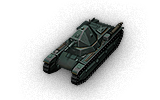Select your region to log in.
Crew:
- Commander (Radio Operator, Gunner, Loader)
- Driver
Advantages:
- Very well armored
- Oddly shaped turret will confuse people on where to fire
- Diesel engine has a reduced chance of engine fire
- 25 mm cannon is quick firing, accurate (relatively), and fast aiming, though having less damage per round
- 47 mm SA35 has decent damage for the tier
Disadvantages:
- Slow
- Extremely poor gun depression on the 25 mm Raccourci; also loses the gun mantlet with this gun
- Poor rate of fire, accuracy, and aiming time on the 47 mm SA35
- Almost completely useless in a Tier 5 battle
- Below average view range, signal range, and hitpoints
Tank description:
The AMX 38 is a French tier 3 light tank.Developed in 1937–1938 under the "20-ton vehicle" project and was intended to replace the D2 tank. The project included two turret variants: with a 37-mm or a 47-mm gun. By 1938, two vehicles were built for trials. Never saw mass production.It has excellent armor for its tier and the angular turret and hull are effective in causing shots to bounce. This tank is best played as a front line heavy tank, bouncing hits and using your DPM to your advantage. Like other low tier French tanks, it has a low top speed and poor gun handling characteristics. The upgraded engine only adds 10 additional horsepower and does little to mitigate the problem. It starts with the 37 mm SA38 which has serviceable penetration and handling for a stock gun. The first "upgrade", the short-barreled 47 mm SA34, offers worse accuracy and abysmal penetration for a small increase in damage and should be avoided. It is best to upgrade to the quick firing 25 mm Raccourci or the 47 mm SA35 - the latter is an essential module in the AMX 40 tree.The AMX 38 leads to the AMX 40.
Developed in 1937–1938 under the "20-ton vehicle" project and was intended to replace the D2 tank. The project included two turret variants: with a 37-mm or a 47-mm gun. By 1938, two vehicles were built for trials. Never saw mass production.

 Русский
Русский English
English Russian region
Russian region North-american region
North-american region European region
European region Asia region
Asia region Korean region
Korean region


 1 270
1 270
 3 900
3 900



